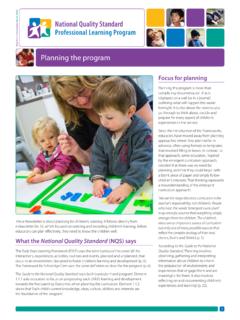Transcription of Screen time - ACHPER QLD
1 Screen time A Joint Australian, State and Territory Government initiative under the National Partnership Agreement on Preventive Health The Get Up & Grow recommendations suggest that children less than 2 years of age should not spend any time watching a Screen , and children from 2 5 years of age should not spend more than one hour per day. This includes time spent in care, as well as time at home. Screen time is defined as anytime a child is watching a Screen , such as through a television, computer, tablet, or Smartphone. Whilst limited amounts of Screen time may have a place, if a child is spending time watching a Screen this is taking quality time away from social interaction and being physically active. Some early childhood settings use Screen time , especially in long day care settings where some children are in attendance for extended periods of time . However, settings should have in place a policy to manage this and the policy should be communicated to parents.
2 See the factsheet Physical activity and Screen time policies for further information. If Screen time is used with children on any given day, there should be a communication method to convey this to the parents so they are aware that the recommended time has been utilised during the period of care. This can be done via: Direct communication with the parent when they collect their child/children The communication book A note on attendance (sign in) sheets A sign on the entry door showing how much of a child s allowed Screen time has been used on that particular day, in accordance with the parents nominated allowance of viewing time . Other methods as determined by the education setting The National Physical Activity Recommendations for Children 0-5 Years provide the following reasons why it is important to minimise the use of Screen time : A variety of TV programs have been created for children under 2 years, however it is questionable whether TV enhances physical development in the first two years of life.
3 There is some evidence indicating that TV watched in the first two years of life may be associated with delays in language development. Research has also found that the distraction of background television can interfere with children playing and interacting with family members and others, which are important for language development. In addition, research has found that each hour of daily TV watched by children under the age of 3 years is associated with poorer reading and intelligence, and that greater amount of TV viewing as an infant is related to an increased likelihood of attention problems at age seven. Screen time A Joint Australian, State and Territory Government initiative under the National Partnership Agreement on Preventive Health Perhaps the most important factor for parents and carers to consider is the undeniable benefits associated with children participating in active play and interacting with others.
4 Through play and interaction young children learn valuable movement and communication skills. If you are including Screen time in your program, consider ways to make it more physically active. These may include: DVDs that contain enough music to encourage children to be active or dance, such as The Wiggles, Hi-5, The Hooley Dooleys, The Fairies or Bindi the Jungle Girl Play School, which encourages children to move their bodies in lots of different ways during the program The Upside Down Show which encourages interesting and hilarious ways to move. Specific Physical Activity DVD s such as the Get Activated series by Active Kidz. Electronic games that require children to get up and moving, for example WiiFit Links to National Quality Standard (NQS) and Early Years Learning Framework (EYLF) Reference: Commonwealth of Australia, Department of Health and Ageing.
5 (2010). Move and Play Every Day: National Physical Activity Recommendations for Children 0-5 years. Retrieved from EYLF Principle 2: Partnerships EYLF Practice: Holistic approaches EYLF Learning Outcome 4: Children are confident and involved learners Children resource their own learning through connecting with people, place, technologies and natural and processed materials EYLF Learning Outcome 5: Children are effective communicators Children use information and communication technologies to access information, investigate ideas and represent their thinking NQS Quality Area 2: Children s health and safety NQS Element : Physical activity is promoted through planned and spontaneous experiences and is appropriate for each child



